Intel’s first-generation Arc graphics cards are here — codenamed Alchemist. It’s a bid to shift the balance that Nvidia and AMD have maintained for decades, with modern furnishings like real-time ray tracing and AI-assisted supersampling. Arc Alchemist is gunning for the top of the best graphics card list, and it has some serious power to get there. If you want to see how much power, make sure to read our Arc A770 and A750 review.
To get you up to speed, we rounded up everything we know about Arc Alchemist’s release date, price, specs, and performance.
Intel Arc Alchemist price and release date

After a long wait and a lot of delays, Intel has finally announced the release date for the Arc A770 and A750. The GPUs will arrive on October 12, which is, coincidentally, the same day as the new Nvidia flagship, the RTX 4090. The prices start at $290 for Intel’s own Limited Edition cards and may be higher for the custom versions from Intel’s partners.
Here’s how Intel is positioning prices:
- Arc A770 16GB — $350
- Arc A770 8GB — $330
- Arc A750 8GB — $290
- Arc A380 6GB — $140
There are 16GB and 8GB versions of the A770, but Intel is only selling the A770 16GB and A750 in its Limited Edition reference design. For the lower-tier Arc A580 for desktops, Intel hasn’t shared pricing or release date details yet.
Over the months leading up to the release of the Arc A770, Intel has emphasized that it plans to stay competitive in terms of pricing. That is its plan for beating the competition — lower prices with decent performance as opposed to targeting the high-end enthusiast segment just yet. For that reason, Intel has priced the A770 very competitively, and it made a strong statement on current GPU prices.
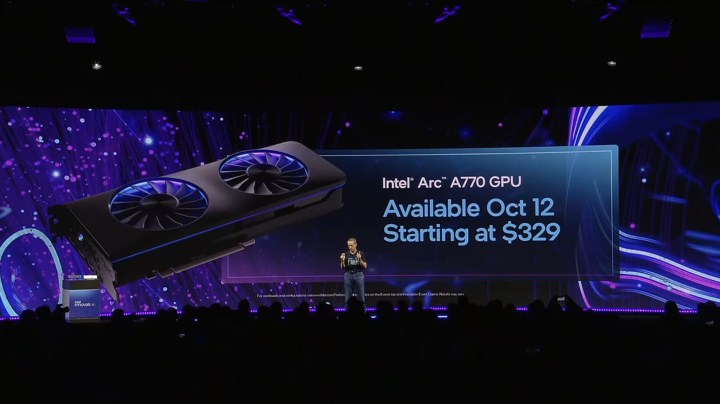
Launching Arc Alchemist has been a herculean task for Intel. Intel officially launched Arc Alchemist at CES 2022, but only the mobile range. After that, Intel said that over 50 laptop and desktop designs were “coming soon,” but we haven’t seen too many yet. The company has confirmed that one Arc Alchemist laptop is shipping in South Korea, but even though it’s been a while, these laptops haven’t become widespread. You can, however, find some of them globally.
Rumors suggest that the slip in release date is a consequence of internal delays. Shortly after Intel’s CES keynote, the company removed the release window from the Arc Alchemist website. Rumors have circulated that Intel delayed the release over issues with management. The cards were originally set to launch in the first quarter of 2022, which Intel just barely made by releasing the range on March 31.
The desktop GPUs suffered numerous delays, too, with an ever-moving launch window that slipped past Intel’s estimates of “the summer of 2022.” However, we now have a concrete date and a very promising price to go with it.
Intel Arc Alchemist specs
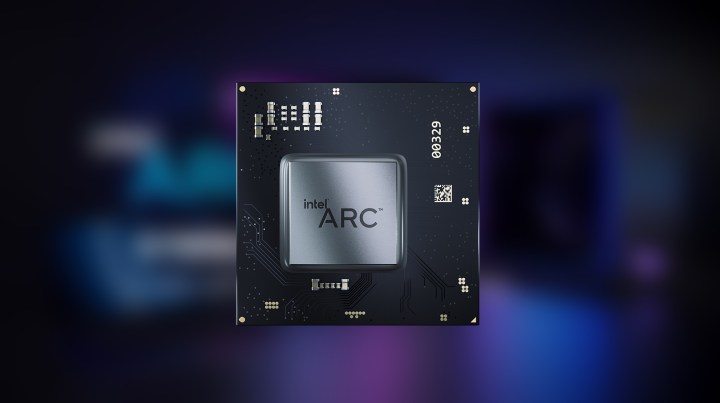
Intel has now revealed full details for both the Arc Alchemist mobile lineup and the desktop range. While we’re not sure when some of these desktop GPUs will be available, we expect them to launch soon, alongside the flagship.
Here’s a look at the mobile range of Arc Alchemist GPUs:
| Xe Cores/RT units | Graphics clock | Memory size | Memory bus size | Power | |
| Arc 7 770M | 32/32 | 1.65GHz | 16GB | 256-bit | 120-150W |
| Arc 7 730M | 24/24 | 1.1GHz | 12GB | 192-bit | 80-120W |
| Arc 5 A550M | 16/16 | 0.9GHz | 8GB | 128-bit | 60-80W |
| Arc 3 A370M | 8/8 | 1.55GHz | 4GB | 64-bit | 35-50W |
| Arc 3 A350M | 6/6 | 1.15GHz | 4GB | 64-bit | 25-35W |
It’s impossible to compare Arc Alchemist’s specs to options from AMD and Nvidia, outside of memory size and power draw. With 16GB of GDDR6 memory and a 256-bit bus, the flagship Arc 7 770M looks like it will line up with Nvidia’s RTX 3080 Ti mobile. AMD doesn’t have any options with quite as much memory.
On the low end, the Arc A350M doesn’t have a direct competitor from AMD or Nvidia, at least based on the spec sheet. This is a highly efficient discrete GPU, targeting 1080p and competing with integrated graphics or entry-level discrete GPUs like Nvidia’s MX450.
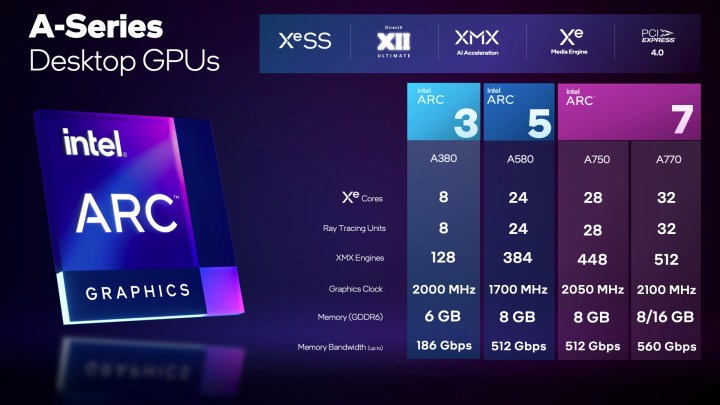
As for Intel Arc Alchemist for desktops, although we’ve heard many rumors about the GPUs targeting the flagships from Nvidia and AMD, we now know that is not the case. The Arc A770 can be compared to an Nvidia GeForce RTX 3060 Ti, and it only goes downhill from there. Intel aims at the mid-to-entry-level sector this time around, but at least the pricing reflects that choice.
Here are the specs of Intel Arc Alchemist for desktops:
| Xe Cores/RT units | Graphics clock | Memory size | Memory bus size | Power | |
| Arc 7 A770 | 32/32 | 2.1GHz | 16GB/8GB | 256-bit | 225W |
| Arc 7 A750 | 28/28 | 2.05GHz | 8GB | 256-bit | 225W |
| Arc 5 A580 | 24/24 | 1.7GHz | 8GB | 256-bit | 175W |
| Arc 3 A380 | 8/8 | 2.0GHz | 6GB | 96-bit | 75w |
Intel Arc Alchemist architecture
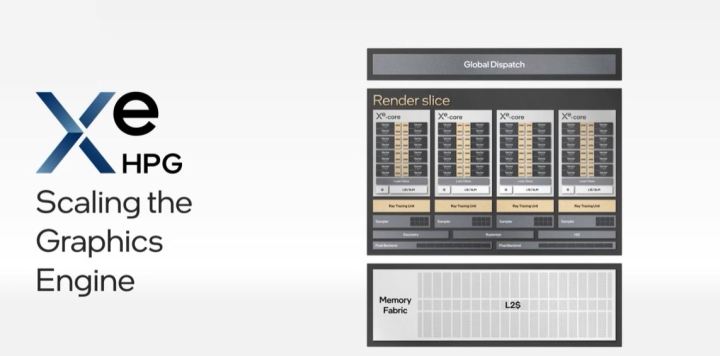
Intel’s Arc Alchemist cards are being built on chipmaker TSMC’s N6 node, which is a revision of the N7 node used on AMD RX 6000 graphics cards.
The basis of Xe HPG is a Xe Core, which features 16 vector units and 16 Xe Matrix Execution (XMX) units, along with an L1 cache. Intel combines four of these Xe Cores into a render slice and adds a shared L2 cache between them, as well as dedicated ray tracing cores for each Xe Core. These slices are what will separate the various Arc Alchemist cards.
Intel says it can add up to eight slices to a graphics card, totaling 32 Xe Cores and 512 XMX and vector units. We don’t know how future architectures will work, but Intel says that Xe HPG is a scalable architecture. In the future, we’ll likely see smaller, more efficient processes alongside more render slices on a card.
Intel Arc Alchemist benchmarks and performance
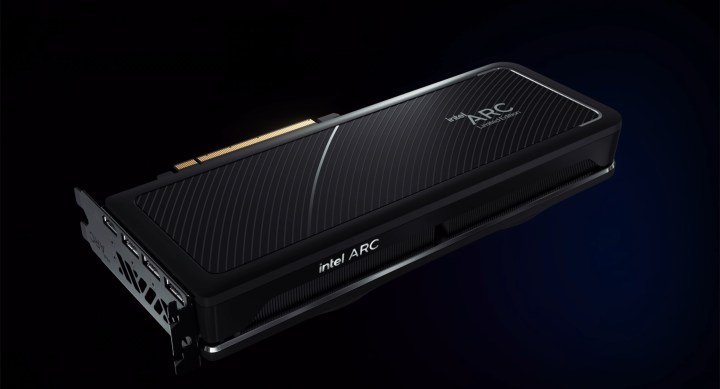
The initial hope was that Intel Arc A770 might be able to target Nvidia’s RTX 3070 Ti or even higher with its performance. Intel has now confirmed that will not be the case and has compared the GPU to the RTX 3060 Ti. The Arc A750 has a similar set of specs trade blows with the RTX 3060, while the Arc A580 can hope to compete with the RTX 3050 or lower.
For a while, we’ve mostly had bad news about the performance of Intel Arc. Driver issues prevented the GPUs from doing a good job, and it was also revealed that the GPUs may always struggle in some games. This is because they’re optimized for modern APIs, like DirectX 12 and Vulkan, but not for DirectX 11 and older, which could make them perform poorly in older titles. Intel is aware of this and is actively working on it.
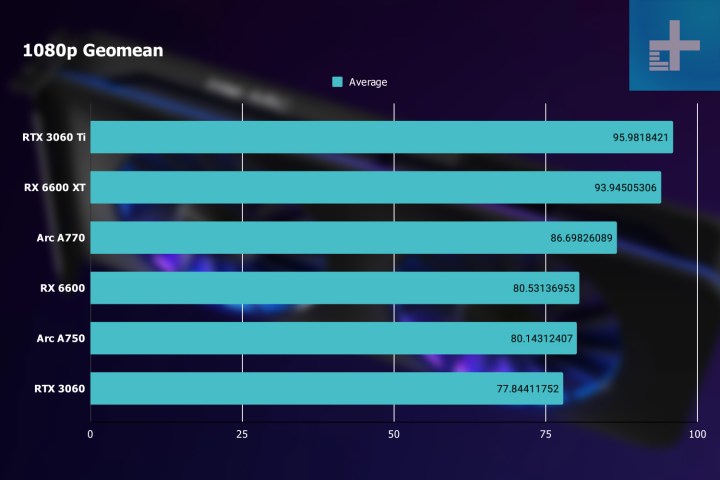
Our test suite focuses on DirectX 12 and Vulkan, and both the Arc A770 and A750 shine. You can see our results across 1080p below. Both GPUs beat out the RTX 3060 for around the same price, but the A770 16GB surprisingly nears the performance of an RTX 3060 Ti. And the actual frame rates are highly playable.
In Forza Horizon 5 with maxed-out settings at 1080p, the Arc A770 16Gb managed an 85.9 frames per second average, while the A750 was close behind with a 79.2 fps average. Cyberpunk 2077 shows a slightly different side of the story, though, with the A770 and A750 managing a 58.5 fps and 55.6 fps average, respectively. This is the only title we tested where the RTX 3060 beats the two Arc GPUs.
On the other hand, Arc seems particularly well-suited for Vulkan games like Red Dead Redemption 2. At 1080p Ultra, the A750 managed 85.9 fps while the A770 16GB pulled off 93.2 fps, even beating out the RTX 3060 Ti.
Our 1440p results (below) tell much of the same story, though the cheaper ARc A750 establishes a stronger lead over the RTX 3060, while the A770 16GB starts competing on the level of an RTX 3060 Ti.

As for the mobile cards, they are (sort of) here, but the benchmarks have still been fairly sparse. We’ve seen synthetic benchmarks of the Arc A770M and A750M, in which the flagship was able to compete with Nvidia’s RTX 3070. Intel itself has also released some official benchmarks of the cards, but vendor benchmarks are not always the best source when it comes to gauging performance. In these tests, the Arc A770M was faster than the RTX 3060 mobile, and the Arc A730M beat the RTX 3050 Ti mobile.
We’ve also spotted a YouTuber who was able to score a machine with an Arc A350M. The video shows the card managing around 90 frames per second (fps) in Overwatch at High settings.
In a more demanding title like Red Dead Redemption 2, the card stayed under 30 fps, occasionally dropping as low as 15 fps. Similarly, the card jumped between 30 fps and 45 fps in Elden Ring with High settings. Although not ideal, it’s important to remember that the A350M is the most entry-level GPU in Intel’s Arc Alchemist range.
Intel has shared some benchmarks for its A370M as well. The graph (below) only shows the card compared to Intel’s older integrated graphics, but the A370M puts up respectable frame rates. The card was able to manage about 60 fps in demanding titles like Hitman 3 and Doom Eternal at 1080p, which is nothing to sneeze at.
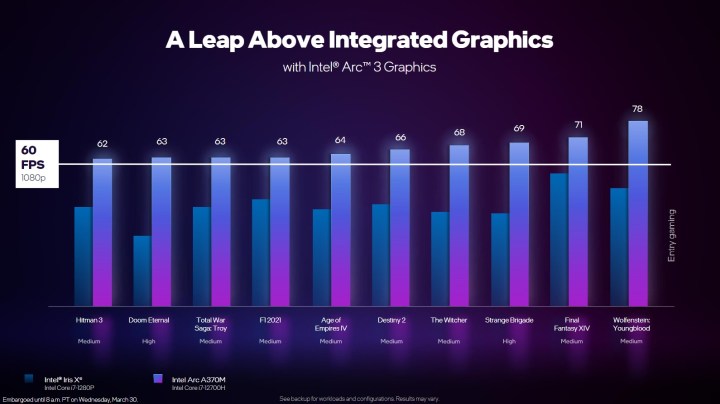
For now, we have to turn to leaks and rumors for any performance hints, but it won’t be long until the desktop range is released and Intel Arc can be seen in its full glory.
Intel Arc Alchemist overclocking
We have more concrete information about overclocking. Intel has confirmed that Arc drivers will feature a built-in overclocking utility, allowing you to push the clock speeds past their rated spec. We don’t know what the overclocking tool will look like, but we hope it matches up with the offerings from AMD and Nvidia.
Intel’s Tom Petersen revealed that Arc Alchemist might do a particularly good job at overclocking without ramping up the power consumption. A significant overclock was achieved at virtually no extra energy cost.
In an interview with Gadgets 360, Intel said it’s exploring multiple features for its drivers. The drivers will line up with major game releases, and the company is looking into features like gaming recording and streaming. That said, these features may not be available when the cards launch.
Real-time ray tracing and Intel XeSS
Alchemist cards come with the latest gaming features, including support for DirectX 12 and Vulkan ray tracing, which comprise the vast majority of titles that support ray tracing available today. And the performance is solid.
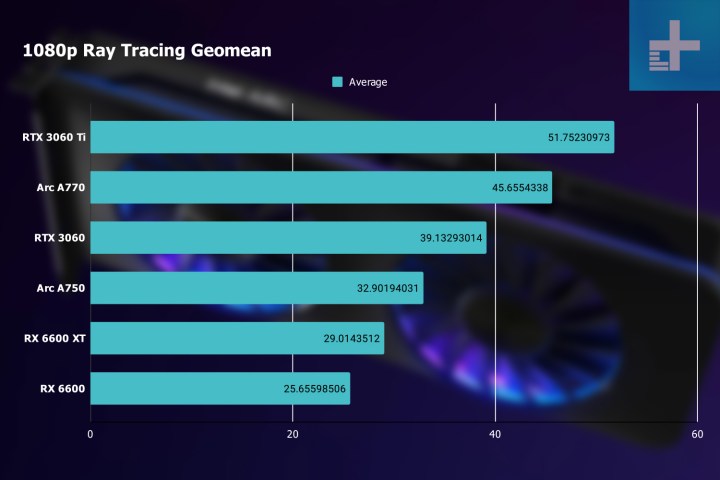
As you can see in our benchmark chart above, the Arc A770 and A750, at least, near the level of Nvidia’s ray tracing performance. That’s far ahead of AMD currently, which has traditionally taken a distant backseat to Nvidia in ray tracing performance. Although the A770 and A750 aren’t top-notch, they’re at least competitive with Nvidia’s current lineup.
Alongside ray tracing, the cards support Intel XeSS. This is an AI-assisted supersampling feature that works similarly to Nvidia’s Deep Learning Super Sampling (DLSS). It’s not as powerful as DLSS, though. You can see our test results with the Arc A750 in Hitman 3 below.

Although similar, XeSS isn’t the same as DLSS. It seems Intel took some notes from rival AMD and its FidelityFX Super Resolution (FSR) upscaling tech. Like FSR, XeSS works across a wide range of hardware, not just Intel graphics cards. To achieve broad support and AI upscaling, Intel developed two software development kits (SDKs).

The first utilizes dedicated cores on Intel graphics cards, similar to how DLSS uses Tensor cores on Nvidia RTX cards. This is the full, fat XeSS experience, and Intel says developers can start implementing it in late August.
Another SDK uses DP4a instruction, which is used in AI applications on recent Nvidia graphics cards and recent Intel integrated graphics. Intel says this version has some quality and performance differences compared to the normal version of XeSS. However, it opens up much wider support for other hardware, which is great to see.
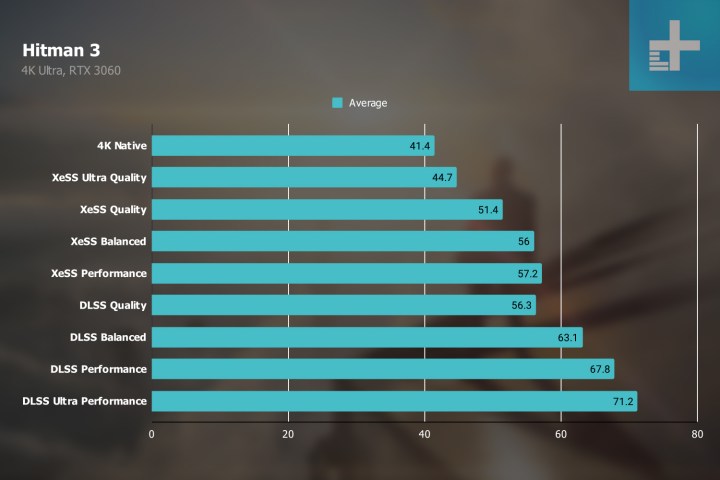
And thankfully, the performance holds up for what XeSS is capable of right now. You can see our performance with XeSS on an RTX 3060 above. DLSS is still leagues ahead in overall performance, but XeSS is still a solid option in games where DLSS isn’t available.






